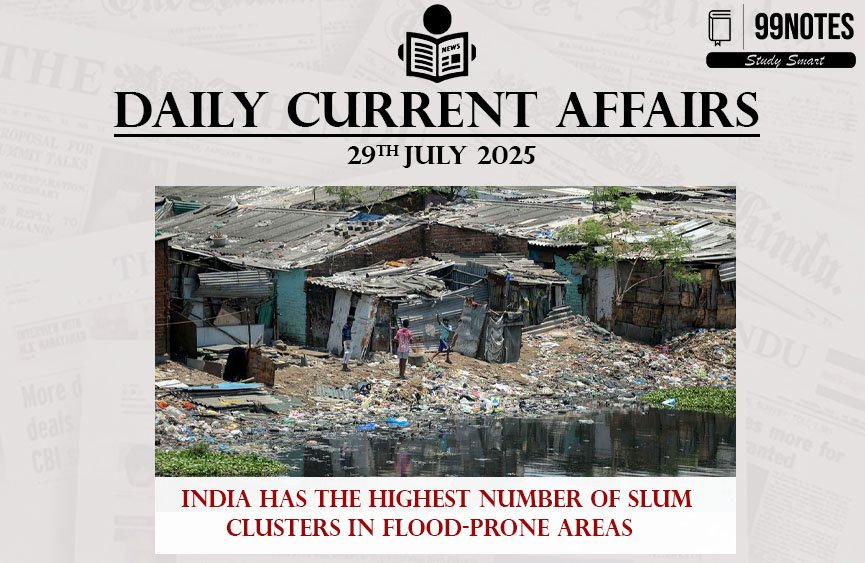29 July 2025 : Daily Current Affairs
1. India Has the Highest Number of Slum Clusters in Flood-Prone Areas
Source: Page 15 , The Hindu UPSC IAS Edition
| Topic: GS-1 – Urbanization, GS3 – Disaster Management |
| Context |
|
Content
Key Findings
-
Nearly 158 million slum dwellers in India live within floodplains, a number that surpasses the population of entire large countries such as Russia.
-
South Asia, and the Ganga delta in particular, emerge as global hotspots for concentrated vulnerability.
-
In total, 33% of informal global settlements (approx. 445 million people across 129 low- and middle-income countries) lie in areas already exposed to flooding; India leads both in absolute numbers and exposure frequency.
Causes
-
Socioeconomic Factors: Limited financial means, social vulnerability, and a lack of viable alternatives force poor populations to inhabit unsafe, low-lying floodplains.
-
Access to Jobs: Proximity to employment opportunities in urban centers compels people to settle near rivers and in other risk-prone areas.
-
Lack of Alternative Housing: Rapid urban expansion driven by both rural-urban migration and birth rates outpaces the creation of affordable, safe housing.
-
Urban Growth Patterns: Developers and authorities often focus infrastructure development on more secure, affluent neighborhoods. Flood-prone zones, left underdeveloped and cheaper, attract informal settlements.
Consequences
-
Increased Flood Frequency & Intensity: Informal settlements amplify the negative impacts of even minor floods due to inadequate drainage and poor construction.
-
Loss of Livelihoods & Homes: Recurrent inundation causes cyclical loss of jobs, housing, and basic services.
-
Exacerbated Inequalities: Lower-income communities face disproportionate losses and have less capacity for recovery, deepening urban inequality.
-
Pressure on Urban Infrastructure: The concentration of slums in vulnerable areas strains city resources, hampers effective disaster response, and can escalate public health crises after floods.
Policy Concerns
-
Infrastructure Bias: Planning and resource allocation often prioritize gated communities and commercial districts, neglecting vulnerable populations in risk zones.
-
Human-Centric Adaptation: Current approaches still under-emphasize participation and empowerment of the affected communities.
-
Skill-Building: Lack of targeted skill development in sanitation, drainage, and flood-resilient construction perpetuates vulnerability.
-
Resilience and City Planning: Inadequate enforcement of zoning laws and insufficient investments in flood mitigation infrastructure in slum areas.
Way Forward
-
Integrate Slum and Flood Management: Flood mitigation and slum upgrading must be treated as interconnected agendas, with a focus on SDGs such as eliminating poverty, ensuring clean water and sanitation, and promoting sustainable cities.
-
Participatory Urban Planning: Direct collaboration with informal settlement communities can yield more effective disaster preparedness and response.
-
Inclusive Resource Allocation: Allocating city budgets and development projects to address the needs of the most at-risk populations.
-
Skill Development Initiatives: Building local capacity for waste management, sanitation, and drainage installation can reduce risks and create jobs.
-
Resilient Urban Infrastructure: Ensuring robust, climate-adaptive urban development, especially in flood-prone zones, so as not to push the poor further into environmental hazards.
Practice Question:
|
“Discuss the challenges of urban flood management in India, focusing on the vulnerability of informal settlements. Suggest holistic solutions for risk mitigation and resilience building.” (250 words / 15 marks) |
2. Focus on Mass Inclusion, Not Exclusion, SC Tells EC
Source: page 1, The Hindu UPSC IAS Edition
| Topic: GS-2 – Polity and Governance |
| Context |
|
Analysis from UPSC Angle:
-
Background: Special Intensive Revision (SIR) of the electoral roll in Bihar has been controversial, with worries about possible exclusion of legitimate voters due to stringent document proof requirements.
-
Court’s Stand: SC emphasized Aadhaar and EPIC have “presumption of correctness” and that focus should be on inclusion rather than widespread exclusion.
-
EC’s Concerns: The EC cited document forgery risks, but the court responded that all identity documents can potentially be falsified and case-by-case examination can address outliers.
-
Importance of Inclusion: The judiciary underscored the constitutional right to vote and warned against mass disenfranchisement, particularly ahead of elections.
-
Way Forward: Encourages robust but flexible verification, vigilance against fraud, and ensuring democratic participation is maximized.
Practice Question:
|
“Critically analyze the tension between ensuring electoral integrity and maximizing inclusion in India’s voter registration processes. Suggest measures to strike a balance.” (250 words / 15 marks) |
3. How the Fair Use Clause is Being Applied to Generative AI
Source: Page 8 & 9, Indian Express Delhi Edition
| Topic: GS-2 – Science & Technology, GS3 – Intellectual Property Rights |
| Context |
|
Key Points for UPSC:
-
Key Cases: Anthropic and Meta judgments; both held that transformative use of copyrighted works to train AI models is likely to be considered fair use.
-
Legal Tests: Courts examine four factors—purpose (transformative?), nature, amount used, and market impact. High threshold for copyright holders to prove negative market impact.
-
Contrast: Thomson Reuters v. Ross Intelligence, where non-transformative AI use was not considered fair use.
-
Broader Impact: Implications for Indian policy, balancing between promoting AI innovation and protecting authors’ rights.
-
Conclusion: Need for adaptive copyright frameworks to keep up with technological advances and support both innovation and intellectual property.
Practice Question:
|
“Evaluate the challenges posed by AI model training on copyright-protected materials. Should India adopt similar legal doctrines to US ‘fair use’ in the context of generative AI development?” (150 words / 10 marks) |
Check more: 27 July 2025 : Daily Current Affairs

